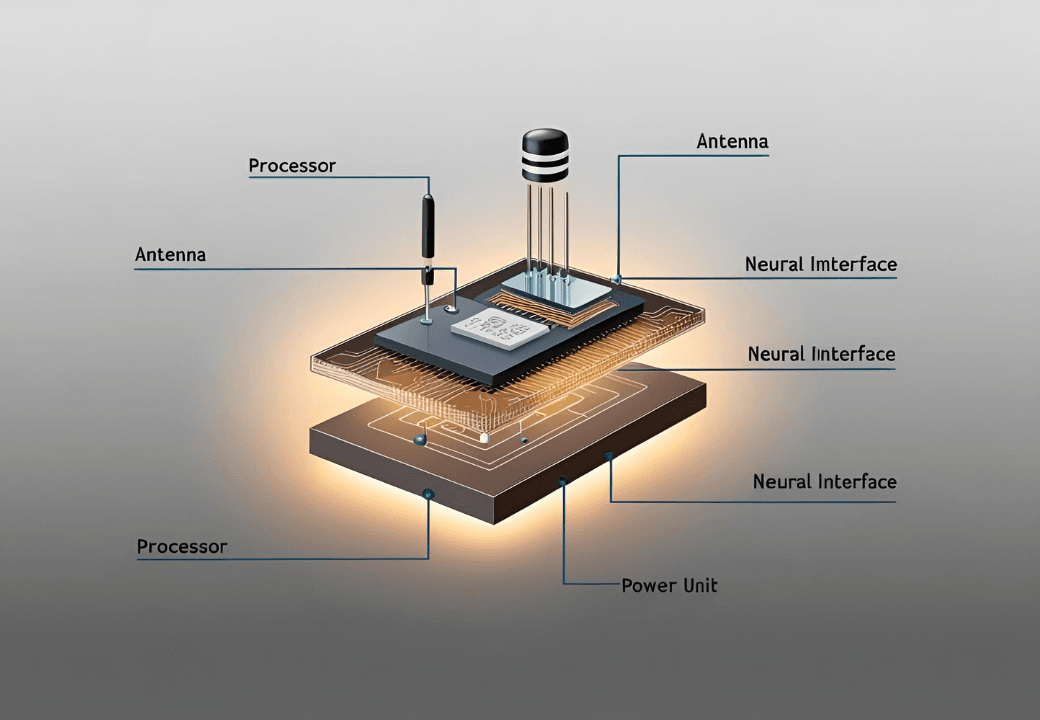Introduction: What If You Could Share Thoughts Like You Share Files?
Imagine a world where thoughts, ideas, and memories could be transmitted from one brain to another as effortlessly as dragging and dropping a file on your computer. No speaking, no typing—just pure, seamless mind-to-mind communication. It sounds like something out of a sci-fi novel, but the foundation for such a reality is already being laid in research labs today.
At the heart of this revolution lies a groundbreaking technology known as neurograins—tiny wireless brain chips developed by researchers at Brown University. These minuscule implants are designed to monitor and even interact with brain activity, enabling a whole new frontier of brain-computer communication.
But what makes neurograins truly game-changing isn’t just their ability to read neural signals. It’s the long-term vision: creating vast networks of wireless brain chips that could one day link multiple human minds together. The idea of collective human intelligence—once considered a dream reserved for fiction—might soon become a technological possibility.

In this blog, we’ll explore the cutting-edge science behind neurograins, how they work, and what they’re already capable of today. We’ll also journey into the speculative future, asking bold questions about what it would mean if our brains could one day connect, collaborate, and even co-think.
Get ready to dive into a world where neuroscience meets imagination—and where the next big leap in human evolution might be digital.
What Are Neurograins?
Neurograins are a groundbreaking advancement in brain-computer interface (BCI) technology, developed by researchers at Brown University. These wireless brain implants are designed to be small, flexible, and capable of both recording and stimulating neural activity. Unlike traditional BCIs that rely on large, rigid electrodes, neurograins are microscale devices, approximately the size of a grain of salt, allowing for minimally invasive implantation and the potential for large-scale neural interfacing.
Key Features of Neurograins
- Microscale Size: Each neurograin measures just a few millimeters across, enabling the implantation of thousands of these devices across the brain’s surface. This extensive coverage allows for detailed mapping and interaction with neural activity over a broad area.
- Wireless Operation: Neurograins operate without the need for external wires or bulky hardware. They communicate wirelessly with a central hub, typically a small patch worn on the skin, which coordinates the network of neurograins and transmits data to external devices for analysis.
- Bidirectional Functionality: These implants are capable of both recording neural signals and delivering electrical stimulation. This dual capability is crucial for applications in neuromodulation therapies, where precise control over neural circuits is required.
- Scalability: The design of neurograins allows for the deployment of large numbers of devices across the brain, facilitating the creation of a “cortical intranet” of interconnected neural sensors. This scalability is a significant advancement over traditional BCIs, which are limited by the number of electrodes they can use.
Development and Collaboration
The development of neurograins is a collaborative effort led by Professor Arto Nurmikko at Brown University’s Carney Institute for Brain Science. The project has received support from various institutions, including Baylor College of Medicine and the University of California, San Diego, as well as funding from the Defense Advanced Research Projects Agency (DARPA). This collaboration brings together experts in engineering, neuroscience, and medicine to push the boundaries of what is possible in neural interfacing.
Comparison with Traditional Brain Implants
| Feature | Neurograins | Traditional BCIs |
|---|---|---|
| Size | Microscopic, millimeter-scale | Larger, typically requiring craniotomy |
| Wireless Operation | Yes | Often requires external wires |
| Scalability | High, with potential for thousands of implants | Limited by number of electrodes |
| Bidirectional | Yes (record and stimulate) | Often unidirectional (record only) |
| Invasiveness | Minimally invasive | Can be invasive, requiring surgery |
In essence, neurograins mark a transformative milestone in brain-computer interface technology, pushing the boundaries of how seamlessly our minds can interact with machines. Their small size, wireless operation, and scalability set them apart from traditional implants, opening up new possibilities for both research and clinical applications in neurology and neuroprosthetics.
How Do Neurograins Work?
Neurograins are cutting-edge neural implants that form a distributed brain-computer interface (BCI) network. Unlike traditional implants that rely on a single device with multiple electrodes, neurograins are tiny, individual nodes—each capable of recording or stimulating brain activity independently. Together, they operate as a scalable and wireless system to interface with the brain’s neural circuits.
Structure of a Neurograin
At their core, neurograins are highly miniaturized, self-contained devices that include three main components:
- Sensors: Each neurograin contains microelectrodes that detect the electrical signals emitted by neurons. These signals are essential for decoding brain activity and translating it into actionable data.
- Power System: Neurograins are wirelessly powered using RF (radio frequency) energy, transmitted from an external hub. This eliminates the need for internal batteries or external wiring, reducing both size and surgical complexity.
- Communication Module: Each neurograin is equipped with a miniature RF antenna. This antenna allows it to send data wirelessly to an external relay device (usually placed on the scalp) that collects the neural data from all active neurograins in real time.

Wireless Communication: The Cortical Intranet
The network of neurograins operates like a “cortical intranet.” Here’s how:
- A wearable external transceiver sends RF energy into the brain, powering hundreds (eventually thousands) of individual neurograins.
- Each neurograin captures and encodes neural signals, then transmits this data back to the transceiver via RF.
- The collected data is then sent to computers or cloud systems for real-time analysis, interpretation, or device control.
This architecture enables real-time, bidirectional communication with the brain without penetrating deeply into neural tissue.
Neurograins vs. Other BCI Technologies (like Neuralink)
| Feature | Neurograins | Neuralink |
|---|---|---|
| Size | Millimeter-scale wireless micro-implants | Larger wired probes connected to a central hub |
| Wireless Operation | Fully wireless (power + data via RF) | Partially wireless; uses USB-C in some models |
| Scalability | Highly scalable (hundreds to thousands of units) | Dozens of electrodes |
| Surgical Invasiveness | Minimally invasive surface placement | Requires robotic surgical implantation |
| Communication Architecture | Distributed mesh of micro-implants | Centralized device with electrode threads |
Neurograins aim for greater scalability and modularity, whereas Neuralink is optimized for high-bandwidth, localized control.
Current Testing and Real-World Trials
Neurograins are currently being tested in preclinical settings, particularly on animal models such as rodents. These studies demonstrate their ability to:
- Record high-resolution neural activity.
- Stimulate specific brain regions with precision.
- Communicate reliably over extended periods without degradation.
Though still in early stages, human trials are on the horizon. The success of this testing phase will pave the way for neurograins to be used in therapies for paralysis, epilepsy, and even mental health monitoring.
In summary, neurograins represent a revolutionary step in brain-computer interface development. With their wireless, minimally invasive design and scalable architecture, these neural implants are poised to redefine how we interface with the brain—offering real-time, intelligent control over devices, therapies, and perhaps even communication itself.
Real-World Applications of Neurograins
As research on neurograins accelerates, their potential impact spans multiple industries—from medicine to mental health and even human cognition. Below, we explore the most promising neurotechnology applications made possible by precise brain signal decoding.
🧠 A. Medical Breakthroughs: Restoring Lost Function
One of the most immediate and transformative uses of neurograins lies in restorative medicine. Because these wireless brain implants are capable of reading and stimulating specific neural patterns, they could help people regain abilities lost due to injury or disease.
Use Case Example:
Imagine a stroke patient who has lost mobility in their right hand. Implanted neurograins detect the brain’s motor intentions and reroute them to an external assistive device or reanimated muscle via stimulation. This could restore natural movement without bulky hardware.
According to a 2021 paper from Brown University, neurograins were able to record and transmit neural activity at a resolution comparable to traditional wired systems, opening new doors for real-time, minimally invasive therapy.
These capabilities mark a new frontier in brain signal decoding, allowing more adaptive and personalized treatments for conditions such as:
- Parkinson’s disease
- Spinal cord injuries
- Epilepsy monitoring and intervention

🧬 B. Cognitive Enhancement: Boosting Brainpower
Another fascinating layer of neurotechnology applications is in cognitive augmentation. With fine-tuned neural feedback, neurograins could one day improve memory, focus, and learning speed—much like software upgrades for the human brain.
Hypothetical Scenario:
Students preparing for an exam wear a headband embedded with external receivers that communicate with their implanted neurograins. These devices monitor cognitive fatigue and adjust the difficulty of learning material in real time, optimizing knowledge retention.
While still speculative, early trials involving animal models have already shown that wireless brain chips can modulate neural circuits, which could eventually lead to enhancements in:
- Information processing
- Decision-making
- Working memory
🧠 C. Behavioral Monitoring: A Mental Health Revolution
Chronic stress, anxiety, and depression affect millions—but diagnosis and treatment often rely on subjective symptoms. Neurograins have the potential to revolutionize mental health care by enabling continuous, objective tracking of emotional and cognitive states through real-time brain signal decoding.
“By tracking real-time brain activity, we aim to recognize early signs of emotional dysregulation and intervene before a full-blown mental health crisis,” notes Dr. Arto Nurmikko, lead investigator on the Neurograin project.
Example Use Case:
A person prone to panic attacks receives subtle alerts from their smartwatch when neurograins detect neural patterns associated with rising anxiety. The device suggests breathing exercises or contacts a caregiver automatically.
This continuous, non-invasive mental health tracking could support early intervention for:
Why It Matters
The beauty of neurotechnology applications lies in their cross-disciplinary impact. From enabling mobility to decoding emotions, the ability to precisely monitor and modulate brain activity with neurograins represents a tectonic shift in how we understand and enhance the human experience.
The Imaginary Angle: A Neural Web for Humanity
Imagine waking up and instantly knowing what millions of others have just learned, felt, or discovered—no typing, no reading, no searching. This is the futuristic promise of a neural mesh—a vast, decentralized brain-to-brain communication network made possible by neurograins and other advanced wireless brain implants. It’s not just about connecting devices anymore—it’s about connecting minds.
🌐 What Is a Neural Mesh?
A neural mesh is the hypothetical evolution of neurograins into a brain-wide, cloud-connected system that allows people to transmit thoughts, emotions, and experiences directly to one another—creating a real-time mental web of human consciousness.
Think of it as the internet, but powered by brainwaves instead of keyboards.
🧠 Shared Learning: One Mind, Many Minds
In a future with an active neural mesh, individual knowledge becomes collective. If one person learns to play the piano, that muscle memory and cognitive framework could be shared with others.
Mini Scenario:
Sophia, a scientist in Tokyo, learns how to solve a complex math problem. Within seconds, that neural pattern is uploaded to the mesh. A student in Nairobi receives the learning pattern as a tutorial—directly experienced, not just watched or read. No more language barriers. No more delayed education.
Such instant learning could:
- Drastically speed up global education
- Democratize elite knowledge
- Erase gaps between expert and novice
💓 Emotional Syncing: Empathy Across the Globe
Beyond knowledge, emotions could also travel across the mesh. You could feel what your partner feels during a stressful meeting, or share joy with your family on the other side of the planet.
Example Day-in-the-Life:
Arjun works in a fast-paced, high-pressure hospital environment in Mumbai. His neural mesh syncs with his spouse back home, who receives subtle emotional data and sends calming feedback—think of it like emotional “likes” sent from one brain to another.
This kind of emotional mirroring could:
- Deepen long-distance relationships
- Help therapists monitor clients in real-time
- Reduce feelings of isolation
🌍 Global Crisis Response: Brain-Powered Collaboration
In times of emergency, a connected mind network could function as a global problem-solving engine. With the right protocols, millions of humans could collaborate on complex crises—disaster response, disease outbreak, or even peace negotiations.
Use Case:
During a future climate disaster, governments and citizens connect via the neural mesh. A shared “mental dashboard” emerges, aggregating real-time emotional feedback, environmental data, and suggested responses—accelerating collective decision-making.
⚠️ The Risks of Neural Interconnection
While the vision of a connected humanity is inspiring, it comes with real speculative risks:
- Emotional Overload: Constant emotional input from others could desensitize or mentally exhaust individuals.
- Echo Chambers: Without safeguards, like-minded neural groups might reinforce bias and suppress dissenting thoughts.
- Manipulation & Hacking: A bad actor could inject thoughts or influence moods in others—leading to propaganda, mass control, or cognitive warfare.
As wondrous as the neural mesh could be, it must be designed with fail-safes to protect autonomy and individuality.
The idea of neurograins evolving into a full-fledged neural web for humanity may seem like science fiction—but many of its foundations are being laid today in labs like Brown University. Whether we choose to build such a system—and how responsibly we use it—will shape not just our future technology, but the very nature of human experience.
Ethical Dilemmas & Privacy Risks
As we edge closer to a world where our thoughts can be digitized, transmitted, and even shared, we must confront an uncomfortable but necessary question: Are we truly prepared for the ethical consequences of mass-scale brain integration?
🧠 Consent: Who Owns Your Neural Data?
With neurograins embedded in the brain, every neural spike, every passing thought, and every emotional fluctuation becomes potential data. But who controls that data? You? The hospital that implanted the device? The tech company that built it?
Is your mind still yours if someone else can access it?
Informed consent becomes vastly more complex. Users must understand not only what data is being collected, but also how it’s stored, who can access it, and how long it’s retained. The risk of exploitative “terms and conditions” for neural implants looms large.
🔓 Hacking the Human Mind
In the digital world, every connected device is a target—and so is every wireless brain chip.
If brain-computer interfaces like neurograins are susceptible to external interference, the implications are chilling:
- Could someone intercept your thoughts?
- Could brain data be manipulated to alter memories, perceptions, or behaviors?
- Could mind-hackers implant ideas or desires without consent?
A future cyberattack might not steal your passwords—it might rewrite your preferences.
Without military-grade encryption and rigorous oversight, wireless neural implants could open the door to a new era of cognitive warfare.
💼 Advertising & Corporate Exploitation
With your brain connected to the cloud, marketers could one day tap into your emotional state in real-time. Imagine scrolling through a feed while your implant silently tracks your reactions—and adjusts ads accordingly.
- Are you anxious? Here’s a calming tea ad.
- Are you feeling lonely? Here’s a dating app suggestion.
- Excited? Time to sell you a vacation package.
What happens when privacy no longer protects your inner world, and corporations treat your mind as prime real estate for monetization?
🧭 Expert Perspectives on Neural Ethics
Dr. Nita Farahany, professor at Duke and author of The Battle for Your Brain, argues that cognitive liberty—the right to control your own mental experiences—must become a new human right in the age of neurotechnology.
A 2023 UNESCO report on brain-computer interface ethics emphasizes that neural data is not like other data—it’s intimate, predictive, and identity-defining. We must approach its use with the same caution we use for genetic data, if not more.
Are we racing into a neural future without building ethical guardrails?
What’s Next?
So far, the world of neurograins is still in its early stages, but progress is undeniably accelerating. Let’s return to reality and look at where we currently stand—and what might come next.
🔬 Current Milestones
- The team at Brown University has successfully implanted neurograins in animal models as part of their ongoing research.
- The chips can record brain activity and transmit data wirelessly using radio frequency (RF).
- Initial experiments have demonstrated scalable communication with dozens to hundreds of neurograins simultaneously—a technical breakthrough.
🧪 Upcoming Trials & Development
- Human trials are anticipated in the coming years, pending safety validations.
- Collaborations with institutions like Baylor College of Medicine and University of California, San Diego aim to push the research from lab to clinic.
Meanwhile, other brain-implant technologies are progressing rapidly:
- Neuralink (by Elon Musk) is focusing on surgical precision and high data bandwidth.
- Synchron has already completed FDA-approved human trials using a less invasive brain interface delivered via the bloodstream.
Compared to these systems, neurograins’ key differentiator lies in their ultra-miniature size and scalability—offering a less invasive, modular alternative.
⏳ The Next 5–10 Years
Over the next decade, we could witness:
- The first commercial neural implants for therapeutic use
- Neural interfaces integrated with AI assistants
- Debates around brain-rights laws and neural surveillance
- A tech race between companies and countries to control the next interface frontier: the human mind
Conclusion: Are We Ready for the Neurograin Future?
The rise of neurograins signals more than a leap in neurotechnology—it hints at a coming shift in what it means to be human.
With wireless brain implants, we are approaching a future where minds could connect, communicate, and even collaborate in ways never before imagined. The potential to restore lost functions, enhance intelligence, and build a collective neural web is as revolutionary as the internet—or perhaps more.
But with such power comes profound peril.
Will this become humanity’s greatest leap—or its most invasive surveillance tool?
The dream of collective intelligence could unite us—or unravel our individuality. The time to ask hard questions, build ethical frameworks, and shape the future we want is now.
Are we ready to connect our minds—or should we pause and rethink?
Fascinated by the idea of brain-connected futures? Don’t miss these mind-expanding reads:
-
🧠 AI Dream Interpretation – Can artificial intelligence really decode your dreams?
-
🤖 Emotion AI: Can Robots Truly Feel or Just Fake It? – A deep look into machines that mimic human emotion.
-
🪞 Smart Mirrors That Diagnose You – How intelligent mirrors are turning your bathroom into a medical lab.
-
🧘 AI Therapists: Rise of AI in Mental Health – Meet the digital counselors changing mental health care forever.
-
🌫️ Neural Dust and the Smart Home Revolution – Discover how microscopic brain sensors are powering mind-controlled environments.
-
🧩 Brain–Computer Interfaces – How direct brain-to-machine connections are reshaping communication, control, and consciousness.






